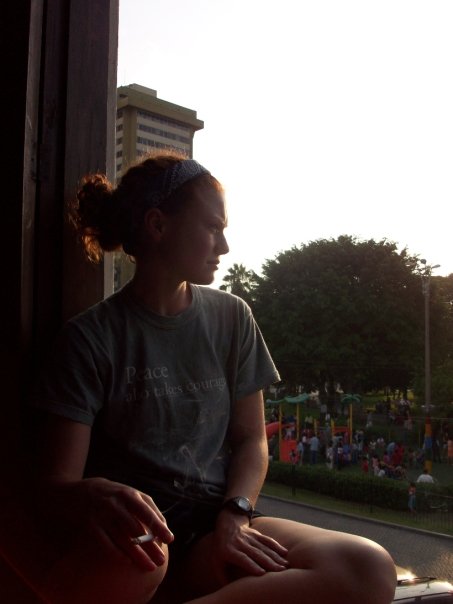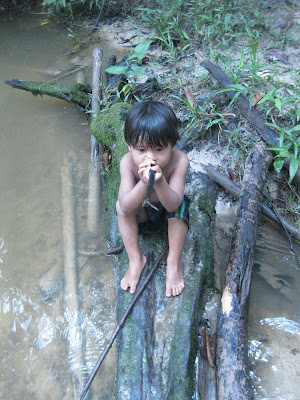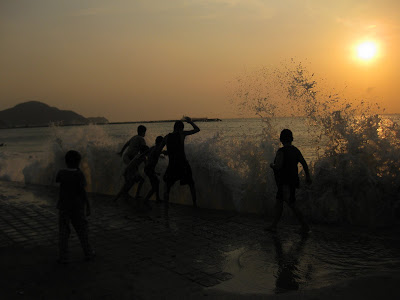Pucallpa is the industrial center of all the Peruvian rain forest with a large port that exports lumber, oil, and every other jungle export that is valued by foreign consumers. Thus, the regional economy is entirely dependent on deforestation and foreign oil companies. I was shocked to see the amount of lumber companies that provided the sole source of income for almost every small village that we passed on the Amazon. To think that thousands of villages rely on the deforestation of the most biodiverse and lush forests in the world seems so entirely hopeless. Moreover, as of recently much of the Peruvian rainforest has been sold to foreign oil companies only further compounding deforestation and also robbing the land from indigenous groups. While in the Amazon, I was made aware of a tragic massacre that occurred between the Peruvian police and a group of peaceful indigenous protesters in Bagua, Peru. Following a free trade agreement that allowed multinational companies to have free access to the natural resources of the Peruvian Amazon, over 30,000 members of inhabiting indigenous groups went on strike, blockading the roads against oil drilling invaders. On June 6, 2009, police dispersed tear gas and opened fire on the indigenous, killing 31 and injuring over 150 people. Not surprisingly, the Peruvian media blamed the ¨savage indians¨ and the global media failed to pick up on the story. If you would like to learn more about this incident, Democracy Now did a good bit of coverage.
¨We´re here to protect you, until you die¨. Machine gun equipped policemen vs. peaceful indigenous people.
After a short stop in Pucallpa, I headed to San Francisco, a Shipibo community located on the Yarincocha lake. This wonderfully peaceful place is inhabited by the Shipibo-Conibo tribe, an indigenous group that is most well known for their tradition artisan work that is influenced by the hallucinogenic plant called ayahuasca. Throughout my travels, I found the Shipibo community to absolutely have the most beautiful artwork I had seen. All of the houses and their clothing are filled with intricate designs and bright colors that tell the stories and preserve their ancient folklore.
En route to Lima, my bus was held up for 3 hours due to a landslide that had scattered debri all over the road. Whilst waiting, I made friends with two travelers whose car was parked behind my bus. I said, ¨Damn, I wish I could spend some time in the high jungle¨, they said, ¨Come with us! we´re going to Tingo María,¨ I said, ¨Let´s go!¨. And so they let me stay at there place in Tingo María, the beautiful land of the the 3 C's: coffee, cacao, and coca. All three crops are exported abroad to happy, high spending consumers, while the farmers are left behind to be haggled daily by the D.E.A of the U.S.A. as well as the Peruvian military. Tingo María always had the beating vibration of US helicoptors floating above our heads.
This is where chocolate comes from, raw cacoa is soo delish.
Beautiful Tingo
The coolest bar I´ve ever been to, the whole wall was filled with jars that had fermenting roots, fruit and leaves in them. The bartender, who appeared to be about 16, knew what every unlabeled jar contained and made the most delicous concoctions.
I did a short stop in Lima, staying with the family of my dear friend Nelson. They definitely treated me right, giving me a proper bed and a hot shower, my first in 4 months. I traveled with my friend Imran to Cuzco to attend the Inti Raymi festival, the annual Incan gathering during the winter solstice to worship and pay homage to the Sun God. The weekend was filled with parades, dancing, and drinking in the streets. Following tradition, a llama was slain and its heart burned on an alter to ensure good crops for the year that would ensue.
The Andes
Inti Raymi festival
Thereafter we made our way down to the Chilean border to renew my visa. Realizing how much money we were wasting on transport, Imran and I decided to hitchhike the remaining 1100 miles from Arica, Chile to Pisco, Peru. I tell you, there is no better way to travel the Pan-American then in the elevated cab of a semi-truck with a panoramic view all around. The stretch was next to the ocean the majority of the way and it was absolutely stunning. We met the coolest truck drivers, like the salsa loving Horacio and chain-smoking Jorge who skipped his sleeping break to drive through the night and take us all the way home.
We made a sign and figured if we played into their typically conservative, religous beliefs we´d find a ride easier. Yes, it says ´may God bless you´ at the end.
Walking across the Chile-Peru border.
Side by side in an effort to eat.
I have been working with an non-governmental charity organization called Pisco Sin Fronteras (Pisco Without Borders). PSF is a grassroots effort that was preceded and handed over by Burners Without Borders, the humanitarian branch of the annual Burning Man Festival. Much like the Burning Man community, PSF changes lives by using creative solutions to solve complex problems. PSF is a group of temporary, untrained, enthusiastic volunteers who are working to reconstruct the community of Pisco. It is a coooperative of creative minds that are motivated to change the livelihoods of Pisqueños by rebuilding family´s homes, schools, and community centers. I have volunteered with many organizations throughout my lifetime, but none as inspiring and unique as this place. My first day volunteering, I went with two other people to fasten a piece of tarp onto the roof of a family´s house so the cold would not get through the many cracks. None of us knew what we were doing, but we were given a tarp, a drill, and screws and by the end of the day the house no longer had a continuous draft running through it. The family thanked us continuously for our small effort, saying that their 13 day old baby would now be able to recover to full health after having conjunctivitis since coming home from the hospital. Every day poses a new challenge, whether it is figuring out how to build a latrine, pour a concrete floor, construct a house supplied with only cane and mud, or pull down a concrete wall with a piece of rope and a jackhammer. The vast majority of the volunteers have never picked up a power tool and within a few days are able to build multiple panels to put together a modular home. I highly suggest you check out the amazingly inspiring video my friends Kelly and Jefe put together about PSF.
Me working a cement mixer, haaaarrrd work.
We had our own burning man as a going away party for the director, TBC.
 |
.jpg)

























































